The Response of Spring Barley (Hordeum vulgare L.) to Climate Change in Northern Serbia
Abstract
1. Introduction
2. Methods
2.1. Experimental Design
2.2. Climatology Prediction
2.3. Model Calibration and Validation
3. Results
3.1. The Model’s Calibration and Validation
3.2. The Expected Air Temperature Shifts During Spring Barley’s Growing Season
3.3. The Time of Sowing, Onset and Duration of Flowering, Duration of Growing Season, and Yield of Spring Barley Simulations
3.4. Changes in Spring Barley Yield Due to Irrigation in the Future and Irrigation’s Economic Feasibility
4. Discussion
4.1. The Impact of Expected Climate Change on the Growth Dynamics and Mean Yield of Spring Barley
4.2. Spring Barley’s Response to Irrigation Under Projected Climate Change
5. Conclusions
Author Contributions
Funding
Conflicts of Interest
References
- Arnfield, A.J. Two decades of urban climate research: A review of turbulence, exchanges of energy and water, and the urban heat island. Int. J. Climatol. 2003, 23, 1–26. [Google Scholar] [CrossRef]
- Đurđević, V.; Rajković, B. Development of the EBU-POM coupled regional climate model and results from climate change experiments. In Advances in Environmental Modeling and Measurements; Mihajlović, D.T., Lalić, B., Eds.; Nova Science Publishers Inc.: New York, NY, USA, 2012; pp. 23–32. [Google Scholar]
- Rowel, D.P.; Jones, R.G. Causes and uncertainty of future summer drying over Europe. Clim. Dynam. 2006, 27, 281–299. [Google Scholar] [CrossRef]
- Lalić, B.; Eitzinger, J.; Mihajlović, D.T.; Thaler, S.; Jančić, M. Climate change impacts on winter wheat yield change—Which climatic parameters are crucial in Pannonian lowland. J. Agric. Sci. 2013, 151, 757–774. [Google Scholar] [CrossRef]
- Downing, T.E.; Harrison, P.A.; Butterfield, R.E.; Lonsdale, K.G. Climate Change, Climatic Variability and Agriculture in Europe: An Integrated Assessment; Research Report No. 21; Environmental Change Unit, University of Oxford: Oxford, UK, 2000. [Google Scholar]
- Parry, M.L.; Canziani, O.F.; Palutikof, J.P.; van der Linden, P.J.; Hanson, C.E. Climate change 2007-Impacts, Adaptation and Vulnerability. In Contribution of Working Group II to the Fourth Assessment Report of the IPCC; Cambridge University Press: Cambridge, UK, 2007. [Google Scholar]
- Eitzinger, J.; Trnka, M.; Semerádová, D.; Thaler, S.; Svobodová, E.; Hlavinka, P.; Šiška, B.; Takác, J.; Malatinská, L.; Nováková, M.; et al. Regional climate change impacts on agricultural crop production in Central and Eastern Europe—Hotspots, regional differences and common trends. J. Agric. Sci. 2013, 151, 787–812. [Google Scholar] [CrossRef]
- Stričević, Z.; Ćosić, M.; Đurović, N.; Pejić, B.; Maksimović, L. Assessment of FAO AquaCrop model in the simulation of rainfed and supplementaly irrigated maize, sugar beet and sunflower. Agric. Water Manag. 2011, 98, 1615–1621. [Google Scholar] [CrossRef]
- Mihajlović, D.T.; Alapaty, K.; Lalić, B.; Arsenić, I.; Rajković, B.; Malinović, S. Turbulent transfer coefficients and calculations of air temperature inside tall grass canopies in land-atmosphere schemes for environmental modeling. J. Appl. Meteorol. 2004, 1498–1512. [Google Scholar] [CrossRef]
- Stričević, R.; Đurović, N. Determination of spatiotemporal distribution of Agricultural drought in Central Serbia (Šumadija). Sci. Res. Essays 2013, 8, 438–446. [Google Scholar] [CrossRef]
- Pinke, Z.; Lövei, G.L. Increasing temperature cuts back crop yields in Hungary over the last 90 years. Glob. Chang. Biol. 2017, 23, 5426–5435. [Google Scholar] [CrossRef]
- Vučetić, V. Modelling of maize production in Croatia: Present and future climate. J. Agric. Sci. 2011, 149, 145–157. [Google Scholar] [CrossRef]
- Cuculeanu, V. Climate change impacts in Romania: Vulnerability and adaptation options. GeoJournal 2002, 57, 203–209. [Google Scholar] [CrossRef]
- Intergovernmental Panel on Climate Change (IPCC). Anex II: Glossary. In Climate Change 2014: Synthesis Report. Contribution of Working Groups I, II and III to the Fifth Assessment Report of the Intergovernmental Panel on Climate Change; Mach, K.J., Planton, S., von Stechow, C., Eds.; IPCC: Geneva, Switzerland, 2014; pp. 117–130. [Google Scholar]
- Food and Agriculture Organization Corporate Statistical Database (FAOSTAT). Available online: http://www.fao.org/faostat/en/#data/RF (accessed on 30 November 2018).
- European Commission (EUROSTAT). Available online: https://ec.europa.eu/eurostat/data/database (accessed on 30 November 2018).
- Grain and Feed Annual Belgrade Serbia. Available online: https://gain.fas.usda.gov/Recent%20GAIN%20Publications/Grain%20and%20Feed%20Annual_Belgrade_Serbia_4-10-2018.pdf (accessed on 21 September 2018).
- Spunar, J.; Blumel, H.; Fouquin, G. Global warming impact—Winter barley as reserve crop for brewing industry in the traditional European countries declaring exclusive or dominant spring malting barley utilization. In Proceedings of the 10th International Barley Genetics Symposium, Alexandria, Egypt, 5–10 April 2008; Ceccarelly, S., Grando, S., Eds.; ICARDA: Aleppo, Syria, 2010; pp. 395–405. [Google Scholar]
- Pržulj, N.; Momčilović, V. Novi Sad varieties of malting barley for the growing conditions of Yugoslavia. Genetika 1998, 30, 453–462. [Google Scholar]
- PPS Sombor. Godišnji Izveštaj o Atestiranim Količinama Semena i Sadnog Materijala u 2017/2018; PPS: Sombor, Srbija, 2017. [Google Scholar]
- Lalić, B.; Mihajlović, D.T.; Podraščanin, Z. Buduće stanje klime u Vojvodini očekivani uticaj na ratarsku proizvodnju. Field Veg. Crop. Res. 2011, 48, 403–418. [Google Scholar]
- Olesen, J.E.; Trnka, M.; Kersebaum, K.C.; Skjelvag, A.O.; Seguin, B.; Peltonen-Sainio, P.; Rossi, P.; Kozyra, J.; Micale, F. Impacts and adaptation of European crop production systems to climate change. Eur. J. Agron. 2011, 34, 96–112. [Google Scholar] [CrossRef]
- Pettersson, C.G.; Eckersten, H. Prediction of grain protein in spring malting barley grown in nothern Europe. Eur. J. Agron. 2007, 27, 205–214. [Google Scholar] [CrossRef]
- Tavakoli, A.R.; Moghadam, M.M.; Sepaskhah, A.R. Evaluation of the AquaCrop model for barley production under deficit irrigation and rainfed condition in Iran. Agric. Water Manag. 2015, 161, 136–146. [Google Scholar] [CrossRef]
- Gerik, T.J.; Rosenthal, W.D.; Duncan, R.R. Simulating grain yield and plant development of ratoon grain sorghum over diverse environments. Field Crop. Res. 1988, 19, 63–74. [Google Scholar] [CrossRef]
- Van Dam, J.C.; Groenendijk, P.; Henriks, R.F.A.; Kroes, J.G. Advances of modeling water flow in variably saturated soils with SWAP. Vadose Zone J. 2008, 7, 640–653. [Google Scholar] [CrossRef]
- Todorović, M.; Albrizio, R.; Životić, L.; Abi Saab, M.T.; Stöckle, C.; Steduto, P. Assessment of AquaCrop CropSyst and WOFOST models in the simulation of sunflower growth under different water regimes. Agron. J. 2009, 101, 509–521. [Google Scholar] [CrossRef]
- El Mokh, F.; Vila-Garcia, M.; Nagaz, N.; Fereres, E. Calibration of AquaCrop salinity stress parameters for barley under different irrigation regimes in a dry environment. In Proceedings of the International Conference on Agricultural and Food Engineering, Kuala Lumpur, Malaysia, 23–26 August 2016. [Google Scholar]
- Vanuytrecht, E.; Raes, D.; Willems, P.; Semenov, M.A. Comparing climate change impacts on cereals based on CMIP3 and EI-Ensembles climate scenarios. Agric. For. Meteorol. 2014, 151, 1753–1762. [Google Scholar] [CrossRef]
- Winter, S.R.; Musick, J.T.; Porter, K.B. Evaluation of screening techniques for breeding drought resistant winter wheat. Crop. Sci. 1988, 28, 512–516. [Google Scholar] [CrossRef]
- Jungclaus, J.H.; Botzet, M.; Haak, H.; Keenlyside, N.; Luo, J.J.; Latif, M.; Marotzke, J.; Mikolajevicz, U.; Roeckner, E. Ocean circulation and tropical variability in the coupled model ECHAM5/MPI-OM. J. Clim. 2006, 19, 3952–3972. [Google Scholar] [CrossRef]
- Mihajlović, D.T.; Mimić, G.; Arsenić, I. Climate predictions: The chaos and complexity in climate models. Adv. Meteorol. 2014, 2014, 14. [Google Scholar] [CrossRef]
- Raes, D.; Steduto, P.; Hsiao, T.C.; Fereres, E. AquaCrop—The FAO Crop Model to Simulate Yield Response to Water Plug in Program Version 5.0 Reference Manual; Food and Agriculture Organization (FAO): Rome, Italy, 2009. [Google Scholar]
- Hsiao, T.C.; Heng, L.; Steduto, P.; Rojas-Laura, B.; Raes, D.; Fereres, E. AquaCrop—The FAO crop model to simulate yield response to water: III. Parameterization and testing for maize. Agron. J. 2015, 101, 448–459. [Google Scholar] [CrossRef]
- Kandić, V. Ocena Genotipova Ječma na Otpornost Prema Suši u Fazi Nalivanja Zrna. Ph.D. Thesis, Univerzitet u Beogradu, Poljoprivredni Fakultet, Beograd, Serbia, 2015. [Google Scholar]
- Mihajlović, D.T. Osnove Meteoroloških Osmatranjai Obrade Podataka; Poljoprivredni Fakultet, Institutza Ratarstvo Povrtarstvo: Novi Sad, Serbia, 1988. [Google Scholar]
- Phocaides, A. Handbook on Pressurized Irrigation Techniques, 2nd ed.; Food and Agriculture Organization (FAO): Rome, Italy, 2007; pp. 159–177. ISBN 978-992-5-105817-6. [Google Scholar]
- Meehl, G.A.; Stocker, T.F.; Collins, W.D.; Gaye, A.J.; Gregory, J.M.; Kitoh, A.; Knutti, R.; Murphy, J.M.; Noda, A.; Raper, S.C.B.; et al. Global climate change projections. In Climate Change 2007: The Physical Science Basis. Contribution of Working Group I to the Fourth Assessment Report of the Intergovernmental Panel on Climate Change; Solomon, S., Qiu, D., Manning, M., Chen, Z., Marquis, M., Averyt, K.B., Tignor, M., Miller, H.L., Eds.; Cambridge University Press: Cambridge, UK; New York, NY, USA, 2007; pp. 749–844. [Google Scholar]
- Kumundini, S.; Andrade, F.H.; Boote, K.J.; Brown, G.A.; Dzotski, K.A.; Edmeades, G.O.; Gocken, T.; Goodwin, M.; Halter, A.L.; Hammer, G.L.; et al. Predicting maize phenology: Intercomparison of functions for developmental response to temperature. Agron. J. 2014, 106, 2087–2097. [Google Scholar] [CrossRef]
- Mihajlović, D.T.; Lalić, B.; Drešković, N.; Mimić, G.; Đurđević, V.; Jančić, M. Climate change effects on crop yields in Serbia and related shifts of Köppen climate zones under the SRES-A1B and SRES-A2. Int. J. Clim. 2015, 35, 3320–3334. [Google Scholar] [CrossRef]
- Holden, N.M.; Brereton, A.J.; Fealy, R.; Sweeney, J. Possible change in Irish climate and its impact on barley and potato yields. Agric. For. Meteorol. 2003, 116, 181–196. [Google Scholar] [CrossRef]
- Pržulj, N.; Mihajlović, V. Spring barley performances in the Pannonian zone. Genetika 2012, 44, 499–512. [Google Scholar] [CrossRef]
- Matthews, R.B.; Rivington, M.; Muhammed, S.; Newton, A.C.; Hallet, P.D. Adapting crops and cropping systems to future climates to ensure food security: The role of crop modeling. Glob. Food Secur. 2013, 2, 24–28. [Google Scholar] [CrossRef]
- Rötter, R.P.; Palosuo, T.; Pirttioja, N.K.; Dubrovsky, M.; Salo, T.; Fronzek, S.; Aikasalo, R.; Trnka, M.; Ristolainen, A.; Carter, T.R. What would happen to barley production in Finland if global warming exceeded 4 °C? Eur. J. Agron. 2011, 35, 205–214. [Google Scholar] [CrossRef]
- Jančić, M. Uticaj Klimatskih Promena na Biljnu Proizvodnju. Ph.D. Thesis, Univerzitet u Novom Sadu, Novi Sad, Serbia, 2015. [Google Scholar]
- Croufurd, P.; Wheeler, T. Climate change and the flowering time of annual crops. J. Exp. Bot. 2009, 60, 2529–2539. [Google Scholar] [CrossRef]
- Trnka, M.; Dubrovsky, M.; Žalud, Z. Climate change impacts and adaptation strategies in spring barley production in the Czech Republic. Clim. Chang. 2004, 64, 227–255. [Google Scholar] [CrossRef]
- Newton, A.C.; Flavell, A.J.; George, T.S.; Leat, P.; Mullholland, B.; Ramsey, I.; Revoredogiha, C.; Russell, J.; Steffenson, B.J.; Swanston, J.S.; et al. Crops that feed the world 4. Barley: A resilient crop? Strengths and weeknesses in the context of food security. Food Secur. 2011, 3, 141–178. [Google Scholar] [CrossRef]
- Nonhebel, S. Effects of temperature rise and increase in CO2 concentration on simulated wheat yields in Europe. Clim. Chang. 1996, 34, 73–90. [Google Scholar] [CrossRef]
- Porter, J.R.; Gawith, M. Temperatures and the growth development of wheat: A review. Eur. J. Agron. 1999, 10, 23–36. [Google Scholar] [CrossRef]
- Kozyra, J. Impact of Projected Air Temperature Change on Winter Cereals Phenology in Poland; Institute of Soil Science and Plant Cultivation State Research Institute: Pulamy, Poland, 2013. [Google Scholar]
- Blecharczyk, A.; Sawinska, Z.; Malecka, I.; Sparks, T.H.; Tryjanowski, P. The phenology of winter rye in Poland: An analysis of long term experimental data. Int. J. Biometeorol. 2016, 60, 1341–1346. [Google Scholar] [CrossRef] [PubMed]
- Mezghani, A.; Dobler, A.; Haugen, J.E.; Benestad, R.E.; Parding, K.M.; Piniewski, M.; Kardel, I.; Kundzewics, Z.W. CHASE-PL Climate Projection Dataset over Poland-Bias adjustment of EURO-CORDEX simulations. Earth Syst. Sci. Data 2017, 9, 905–925. [Google Scholar] [CrossRef]
- Fisher, R.A.; Maurer, R. Drought resistance in spring wheat cultivars I. Grain yield response. Aust. J. Agric. Res. 1978, 29, 897–912. [Google Scholar] [CrossRef]
- Araya, A.; Habtu, S.; Hadgu, K.M.; Kebede, A.; Dejene, T. Test of Aquacrop model in simulating biomass and yield of water deficient and irrigated barley (Hordeum vulgare). Agric. Water Manag. 2010, 97, 1838–1846. [Google Scholar] [CrossRef]
- Nagaz, K.; Toumi, I.; Masmoudi, M.M.; Mechilia, N.B. Soil salinity and barley production under full and deficit irrigation with saline water in arid conditions of southern Tunisia. Res. J. Agron. 2008, 2, 90–95. [Google Scholar]
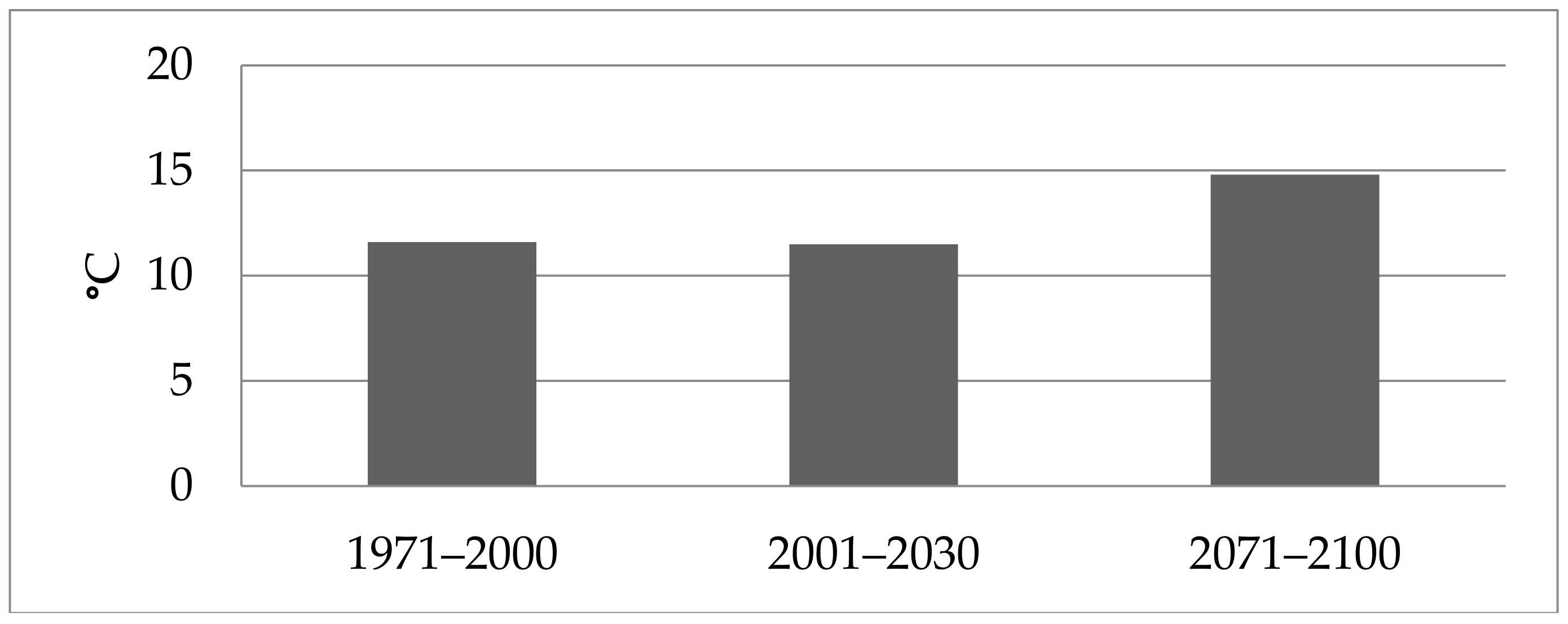
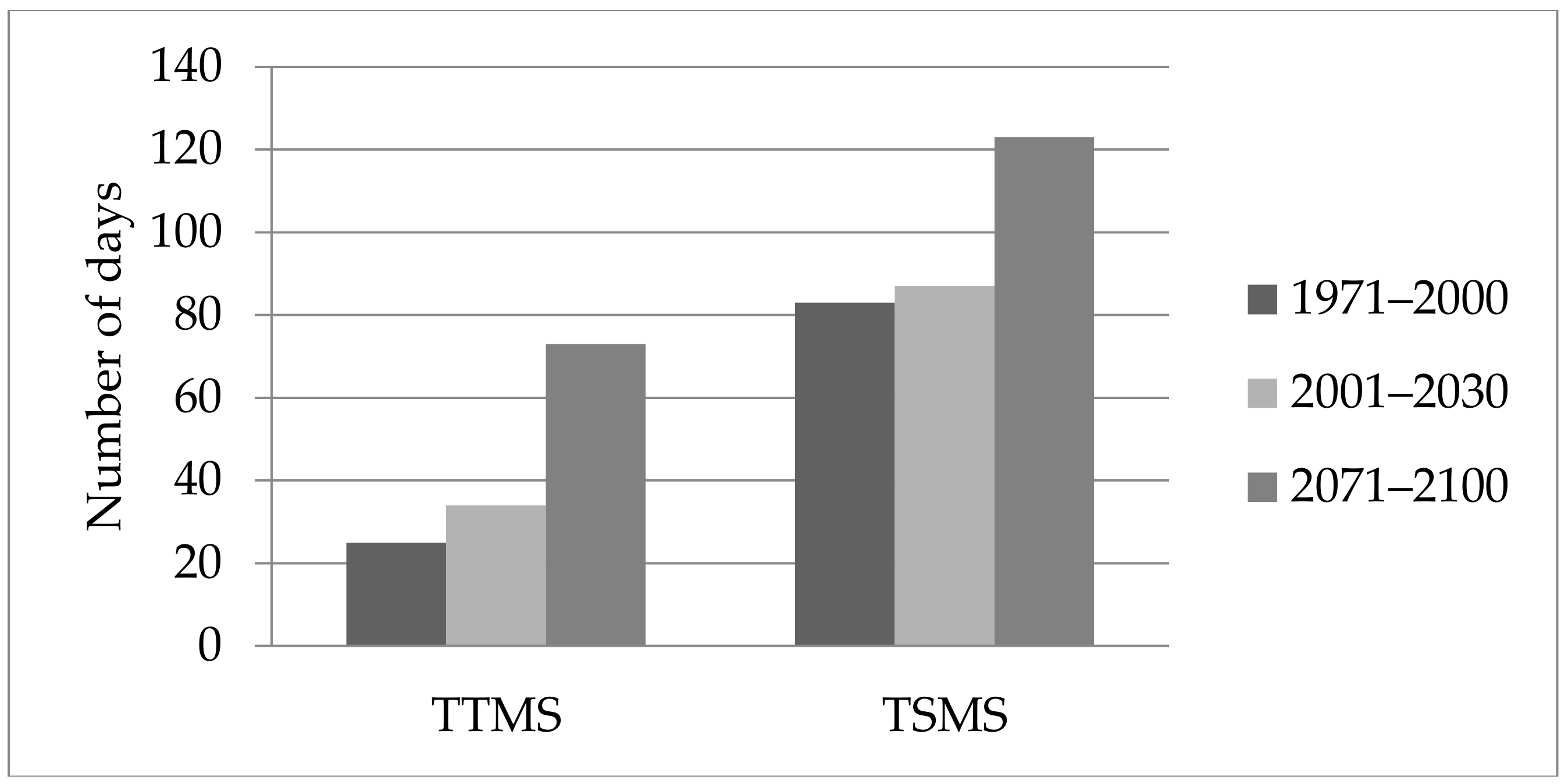
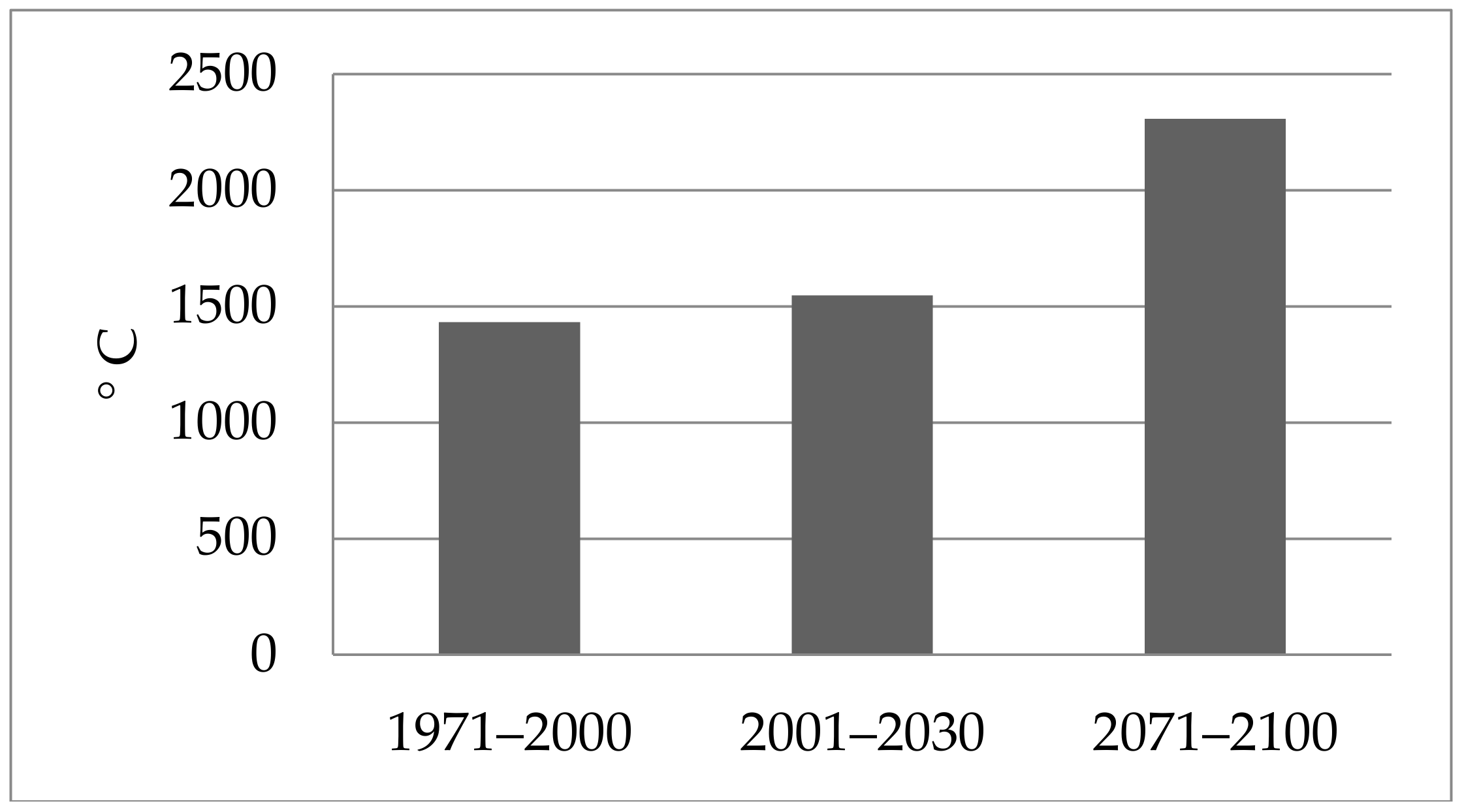
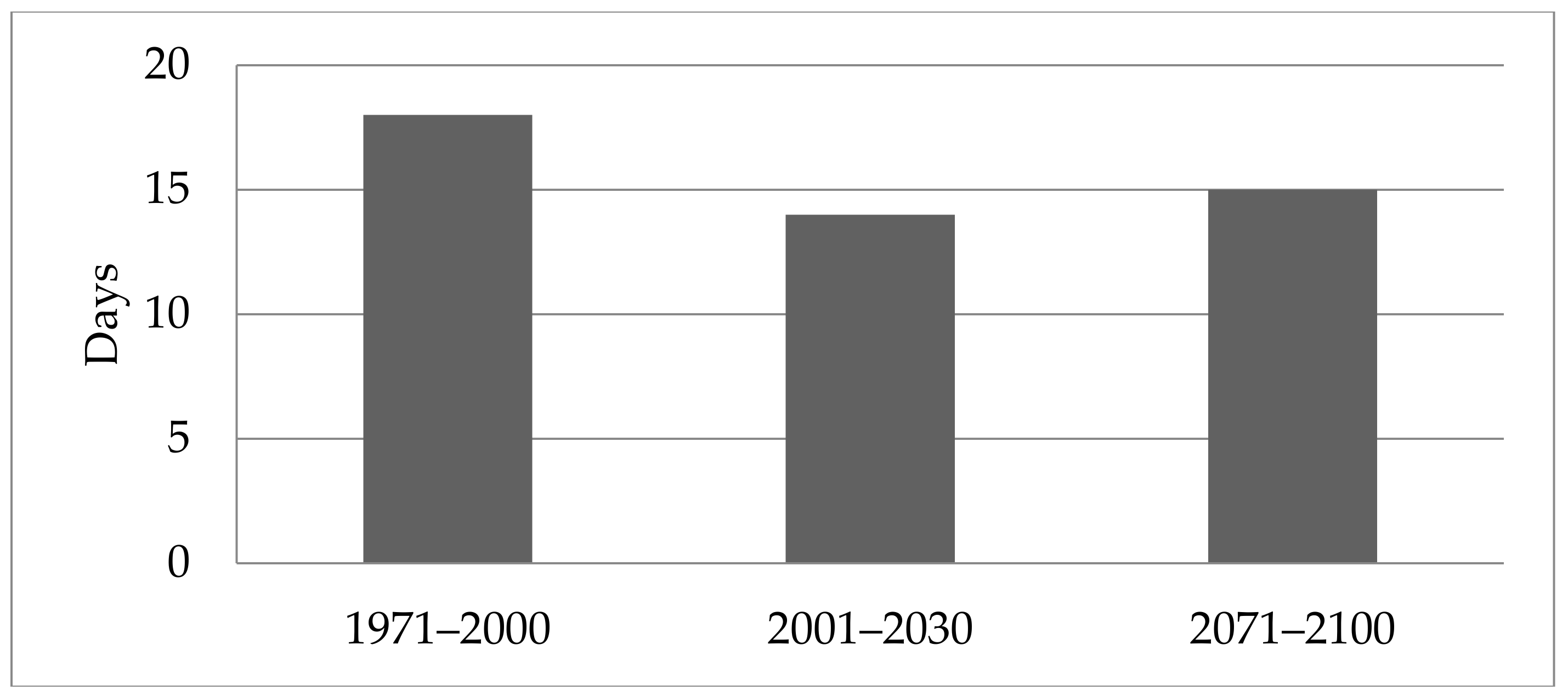
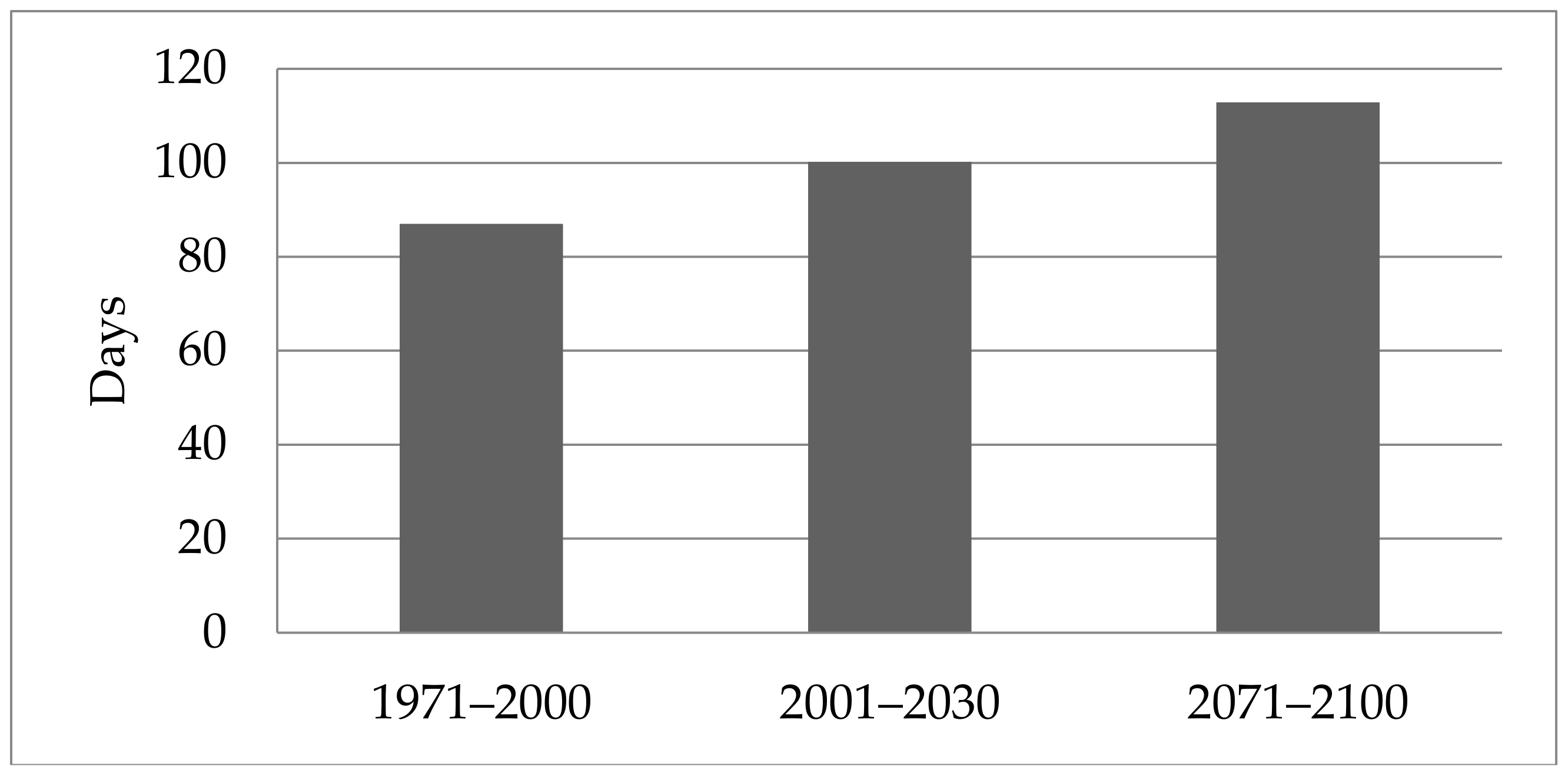
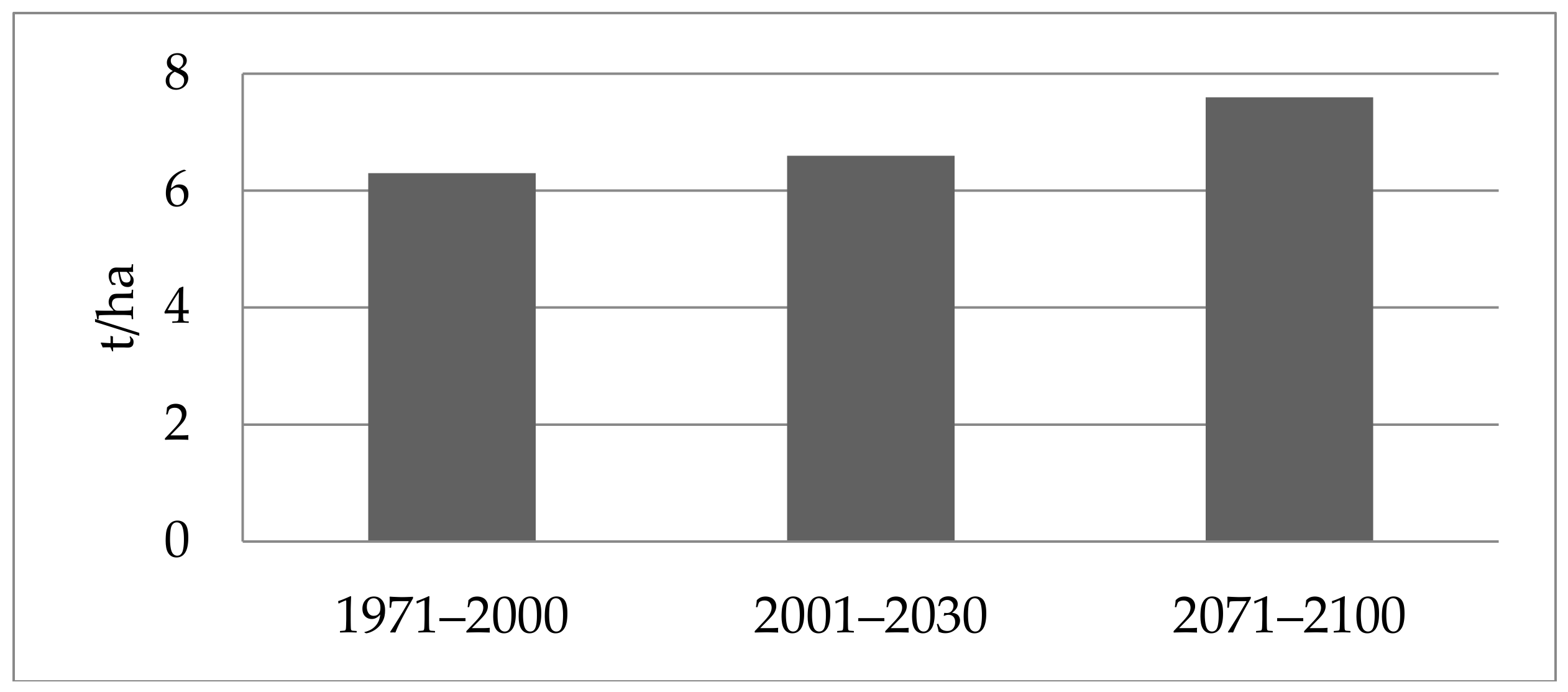
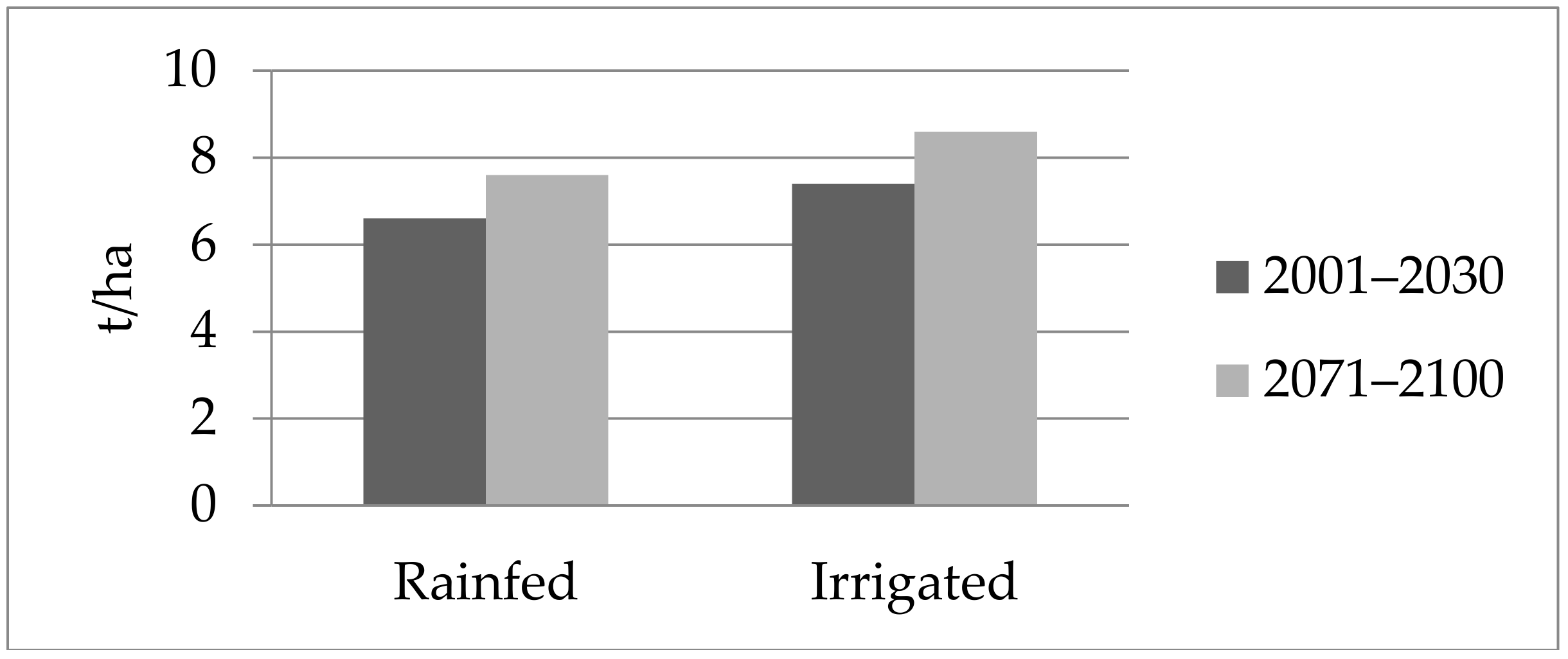
| Location | Depth (m) | Soil Type | Texture | Field Capacity (%) | Wilting Point (%) | Pore Space (%) |
|---|---|---|---|---|---|---|
| Rimski Šančevi | 0–0.30 >0.30 | Chernozem | Loam | 33.8 35.8 | 16.3 20.2 | 54.9 48.8 |
| Crop Input Parameters | Value |
|---|---|
| Crop water productivity (WP), g/m2 | 20 |
| Initial canopy cover (CCo), % | 27.48 |
| Harvest index (HIo), % | 70 |
| Maximum canopy cover (CCx), % | 57 |
| Reduction of canopy expansion, % | 24 |
| Average decline in canopy cover, %/day | 0.08 |
| Crop response for fertility stress, % | 50 |
| Year | Sowing Date | Emergence Date | Flowering Date | Maturity Date |
|---|---|---|---|---|
| 2006 | 10.03. | 28.03. | 24.05. | 6.07. |
| 2007 | 28.02. | 17.03. | 14.05. | 24.06. |
| 2008 | 20.02. | 5.03. | 15.05. | 30.06. |
| 2009 | 3.03. | 23.03. | 16.05. | 4.07. |
| 2010 | 3.03. | 26.03. | 23.05. | 3.07. |
| 2011 | 16.03. | 28.03. | 23.05. | 4.07. |
| 2013 | 20.03. | 8.04. | 27.05. | 7.07. |
| 2014 | 26.02. | 7.03. | 12.05. | 6.06. |
| Plant Density (Plants/m2) | kg Seed/ha | 1000 Seed Mass (g) | Germination Rate (%) | Row Spacing (m) | Plant Spacing (m) | Canopy Size Seedling (cm2) | Initial Canopy Cover (%) |
|---|---|---|---|---|---|---|---|
| 550 | 295 | 51 | 95 | 0.41 | 0.43 | 5 | 27.48 |
| Year | Observed Yield (t/ha) | Simulated Yield (t/ha) | RMSE (t/ha) | MSE (t/ha) |
|---|---|---|---|---|
| 2006 | 8.7 | 7.8 | 0.9 | 0.80 |
| 2007 | 3.4 | 3.5 | 0.1 | 0.01 |
| 2008 | 7.5 | 7.4 | 0.1 | 0.01 |
| 2009 | 5.6 | 6.4 | 0.8 | 0.60 |
| 2010 | 3.2 | 3.3 | 0.1 | 0.01 |
| 2011 | 6.4 | 6.1 | 0.3 | 0.09 |
| 2013 | 3.9 | 3.7 | 0.2 | 0.04 |
| 2014 | 6.0 | 7.1 | 1.1 | 1.20 |
| Year | Observed Grain Yield (t/ha) | Simulated Grain Yield (t/ha) | RSD (%) | Coefficient of Variation |
|---|---|---|---|---|
| 2009 | 5.6 | 6.4 | 9.4 | 0.320 |
| 2010 | 3.2 | 3.4 | 4.3 | 0.020 |
| 2011 | 6.4 | 6.1 | 3.4 | 0.045 |
| 2013 | 3.9 | 3.7 | 3.7 | 0.020 |
| 2014 | 6 | 7.1 | 11.8 | 0.605 |
| Average | 5.6 | 5.7 | 1.09 |
| Cost Element | Sum (€) | Sum (€/ha) | Contribution (%) |
|---|---|---|---|
| Fixed costs | 90,892.45 | 302.97 | 86.45 |
| Variable costs | 14,246.26 | 47.90 | 13.55 |
| Total | 105,138.71 | 350.46 | 100 |
| Description | Year | Average | |||||
|---|---|---|---|---|---|---|---|
| 2011 | 2012 | 2013 | 2014 | 2015 | 2016 | ||
| Price (din/kg) | 18.95 | 22.10 | 20.18 | 17.96 | 16.95 | 16.35 | |
| Euro rate | 103.04 | 101.95 | 113.14 | 117.31 | 120.73 | 123.12 | |
| Price (€/kg) | 0.18 | 0.21 | 0.17 | 0.15 | 0.14 | 0.13 | 0.16 |
| Projected Scenario | Mean Fixed Costs | Mean Variable Costs | Mean Total | Mean Yield Increase (kg/ha) | Mean Price (€/kg) | Mean Income Increase (€/ha) | Economic Result (€/ha) |
|---|---|---|---|---|---|---|---|
| 2001–2030 | 302.97 | 12.08 | 312.27 | 785.60 | 0.16 | 131.64 | −221.17 |
| 2071–2100 | 302.97 | 9.44 | 312.42 | 1032.12 | 0.16 | 172.94 | −139.48 |
© 2019 by the authors. Licensee MDPI, Basel, Switzerland. This article is an open access article distributed under the terms and conditions of the Creative Commons Attribution (CC BY) license (http://creativecommons.org/licenses/by/4.0/).
Share and Cite
Daničić, M.; Zekić, V.; Mirosavljević, M.; Lalić, B.; Putnik-Delić, M.; Maksimović, I.; Dalla Marta, A. The Response of Spring Barley (Hordeum vulgare L.) to Climate Change in Northern Serbia. Atmosphere 2019, 10, 14. https://doi.org/10.3390/atmos10010014
Daničić M, Zekić V, Mirosavljević M, Lalić B, Putnik-Delić M, Maksimović I, Dalla Marta A. The Response of Spring Barley (Hordeum vulgare L.) to Climate Change in Northern Serbia. Atmosphere. 2019; 10(1):14. https://doi.org/10.3390/atmos10010014
Chicago/Turabian StyleDaničić, Milena, Vladislav Zekić, Milan Mirosavljević, Branislava Lalić, Marina Putnik-Delić, Ivana Maksimović, and Anna Dalla Marta. 2019. "The Response of Spring Barley (Hordeum vulgare L.) to Climate Change in Northern Serbia" Atmosphere 10, no. 1: 14. https://doi.org/10.3390/atmos10010014
APA StyleDaničić, M., Zekić, V., Mirosavljević, M., Lalić, B., Putnik-Delić, M., Maksimović, I., & Dalla Marta, A. (2019). The Response of Spring Barley (Hordeum vulgare L.) to Climate Change in Northern Serbia. Atmosphere, 10(1), 14. https://doi.org/10.3390/atmos10010014





